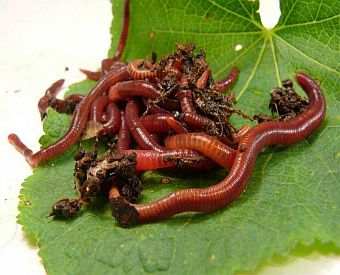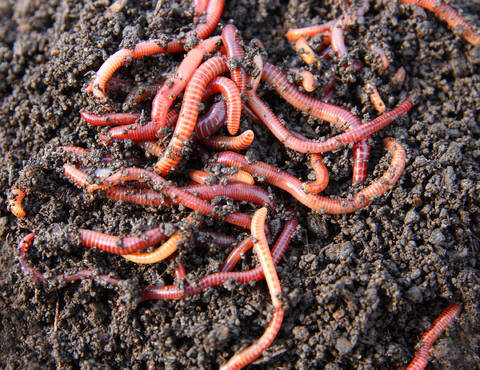Exactly How Red Wigglers Can Increase Your Organic Waste Recycling
Red wigglers stand for a critical part in boosting organic waste recycling, effectively transforming everyday kitchen scraps and garden debris right into important worm spreadings. This process not only reduces the quantity of waste sent out to garbage dumps but additionally enriches dirt vigor, advertising healthier plant growth without the requirement for artificial plant foods. Recognizing the ins and outs of developing a vermicomposting system and the optimal treatment for these worms can considerably intensify the benefits. Yet, the question remains: exactly how can one efficiently incorporate this method right into their regular to make the most of effect?

Advantages of Red Wigglers
Red wigglers, a kind of composting earthworm, deal many advantages that make them vital in natural waste recycling. These worms can process kitchen area scraps, garden waste, and also paper products, changing them into nutrient-rich castings.
Moreover, red wigglers enhance soil aeration and drain via their tunneling tasks, promoting a much healthier origin environment for plants. Their castings are rich in useful bacteria and vital nutrients, fostering durable plant growth and boosting dirt structure (red wigglers). The usage of red wigglers in composting is an eco pleasant alternative to chemical plant foods, which can have unsafe side results.
Furthermore, vermicomposting with red wigglers is a low-maintenance and reliable approach of reusing natural waste, making it obtainable for homes and neighborhoods alike. Their quick reproduction price makes sure a consistent supply for recurring composting initiatives, better intensifying their benefits. On the whole, red wigglers serve as a crucial element in sustainable waste monitoring and dirt enhancement methods.
Establishing a Vermicomposting System
Producing an efficient vermicomposting system needs careful preparation and factor to consider of various factors that contribute to its success. The structure of a successful system starts with selecting a suitable bin. Choices vary from business containers to homemade choices, however it is important that the container is well-ventilated and properly sized to accommodate the number of red wigglers.
Next, the choice of bed linens product is vital. Ideal bed linens includes shredded newspaper, cardboard, or coconut coir, which provides both a habitat and a source of carbon for the worms. The bed linen needs to be dampened yet not overly damp to stop anaerobic problems.
Keeping the optimum atmosphere is important. Red wigglers thrive in temperatures between 55 ° F and 77 ° F(13 ° C to 25 ° C )and call for a pH degree around neutral. Keeping track of moisture degrees is also critical, as too much wetness can bring about odor issues, while insufficient can dry out the worms.
Finally, putting the vermicomposting system in a shaded location safeguarded from direct sunshine will certainly aid keep a steady setting. With these factors to consider in mind, one can properly establish a thriving vermicomposting system that improves natural waste recycling.
What to Feed Red Wigglers
Feeding red wigglers the ideal products is basic to keeping a healthy vermicomposting system. These worms flourish on a diverse diet primarily composed of raw material, which includes fruit and veggie scraps, coffee premises, crushed eggshells, and shredded paper. It is vital to avoid feeding them meat, milk, oily foods, or any type of refined items, as these can produce smells, attract pests, and lead to a harmful environment.
A well balanced diet plan for red wigglers advertises ideal digestion and nutrient manufacturing. Go for a mix of eco-friendly materials, high in nitrogen, such as veggie peels and grass trimmings, and brown products, rich in carbon, like dried leaves and cardboard. This balance guarantees a lasting food resource while maintaining wetness degrees in the worm container.
Moreover, it is advisable to slice or shred larger scraps to expedite disintegration and make the food more available to the worms. Routinely keeping track of the usage price will certainly assist identify the proper amount to feed, stopping overfeeding and maintaining a growing ecological community. By supplying an appropriate diet plan, you not just sustain the health of red wigglers yet additionally enhance the performance of your vermicomposting efforts.
Maintaining Your Worm Container
To make sure the wellness and productivity of your vermicomposting system, keeping your worm bin is crucial. Regular tracking of wetness levels is vital; the bed linen ought to be damp however not soggy. If it comes to be as well wet, excess dampness can result in anaerobic conditions, damaging your worms. On the other hand, if it is too completely dry, worms may come to be inactive or pass away.
Severe temperature levels can stress or eliminate your worms. To attain this, place your container in a climate-controlled setting away from direct sunlight or warmth resources.
Aeration is crucial for oxygen circulation. Gently transforming the bed linen with a garden fork every couple of weeks will certainly help freshen the product and stop compaction. Furthermore, be cautious about the bin's odor. A nasty odor might suggest overfeeding or a discrepancy in the carbon-to-nitrogen ratio. If this occurs, lower feeding and include more carbon-rich products like shredded paper or cardboard.
(red wigglers for sale cheap)
Using Worm Spreadings in Gardening

Worm spreadings, often referred to as "black gold" by gardeners, are a highly nutritious natural fertilizer that can substantially boost soil health and plant growth. These spreadings are generated by red wigglers as they digest organic matter, causing a rich, dark, crumbly substance bristling with beneficial bacteria.
Integrating worm spreadings right into yard dirt improves its framework, oygenation, and dampness retention, developing an ideal setting for root growth. The high nutrient web content of worm castings, including nitrogen, phosphorus, and potassium, adds to energetic plant development and raised returns. In addition, worm spreadings include important trace minerals and enzymes that advertise the overall health of plants, enabling them to better withstand insects and illness.
Worm castings can be used straight to the soil or mixed into potting mixes for container horticulture. A thin layer spread over garden beds or included in compost heap can likewise boost the microbial activity and nutrient account of the compost. As a lasting and environmentally friendly fertilizer alternative, worm spreadings sustain natural gardening practices while decreasing reliance on artificial plant foods, thus cultivating a healthier ecosystem.
Verdict
To conclude, the assimilation of red wigglers into natural waste recycling techniques presents a sensible solution for improving dirt check my source health and promoting lasting horticulture methods. By properly breaking down kitchen area scraps and yard waste, red wigglers add to nutrient-rich worm castings that enhance dirt aeration and wetness retention. This environment-friendly approach not only minimizes landfill contributions yet likewise diminishes the dependancy on chemical fertilizers, ultimately promoting much healthier environments and liable waste management practices.